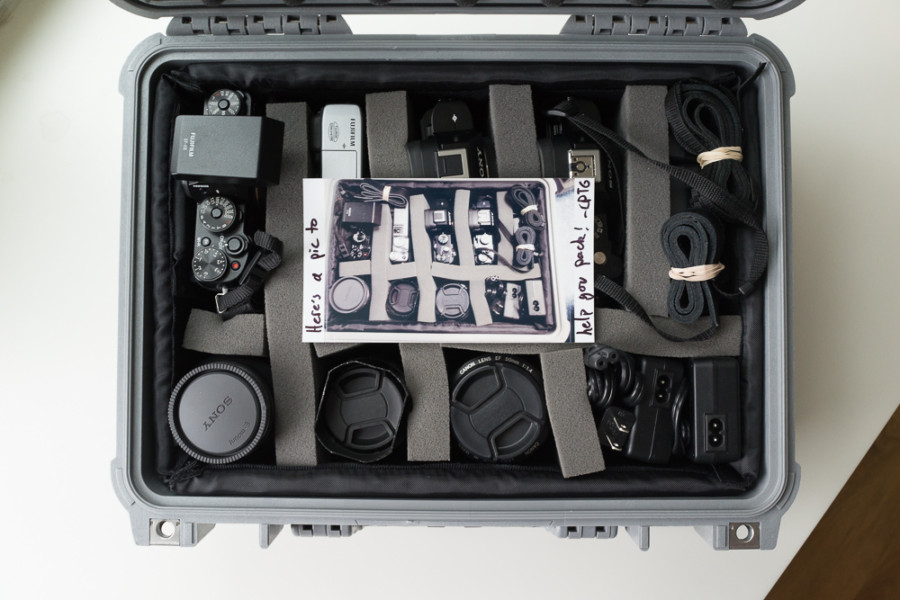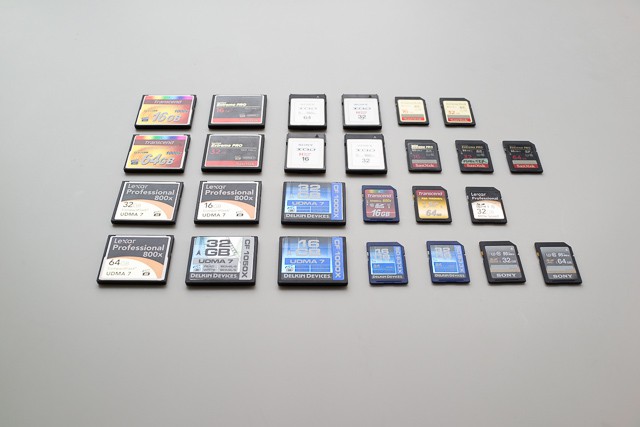
SD/CF/XQD Database
More than two years have passed since Rob Galbraith last updated his CF/SD/XQD Database. Since that time, there has been a significant increase in card/camera performance and the ubiquity of USB 3.0 means transfer rates from card to computer are faster than ever. Our own experience using slower cards in modern, expensive cameras emphasized the point that the camera is only as good as the slowest component, and often, that component was the memory card. After spending $1000 – $7000 on a camera body, we’re too often tempted to skimp on our removeable media without even realizing that we’re compromising the performance of these highly tuned machines.
Having a fast card isn’t a theoretical exercise, nor something that is only relevant to shutter blasting sports photographers. Photographing a sequence of images like a birthday cake being carried to a table and having candles blown out can easily tax a poor performing card in a camera with a small buffer.
Below is an audio test that illustrates the difference between faster and slower cards on the same camera. The cadence of the shutter gives you a sense of how the card handles data writes after the buffer is filled. Cameras like the Nikon D4s have huge buffers, but listen to the difference when the buffer is filled on a Sony S-Series XQD at 0:19 vs an old San Disk Extreme III at 0:55. Insofar as fps is concerned, you’ll consistently get more out of your camera with a faster card.
With Rob’s blessing and advice, we sought to recreate a contemporary database. There’s no way to replicate his findings exactly given the “scene” he chose to photograph could not be realiably recreated. So while we copied the methodology, comparing his results to ours will yield non-sensical results. Instead, we encourage you to examine the relative speeds of each card in each body – as we used the same scene and lens combination in our tests.
With this iteration of the CF/SD/XQD database, we only focused on current, pro-style bodies and cards. For reference purposes, we did test a few slower cards and card readers, but immediately found that we were wasting our time – these devices performed slightly under the “wire” speed of the device (e.g. <40MB/s for USB 2.0), and there was simply no point in including them. As Rob found, there are significant differences in various cards – even within the same vendor. For example, the 32GB card tended to perform noticeably faster than its 16GB brethren.
In all, 1218 test cycles were run to produce the data in this guide. We hope you find this information constructive, and urge you to conduct your own tests to ensure optimal performance of your camera.
Should I upgrade my cards?
If you are using:
- SDHC (80MB/s)
- UDMA-7 CF (>= 120MB/s)
- XQD card
The answer is NO. Cards from specific vendors did perform better than others, but unless you have ultra-critical needs, the performance gain won’t be significant. On the other hand, if you’re using cards that are a few years old, you will find noticeable and significant improvements in read and write speeds, and we would recommend that you upgrade. The difference between a 45MB/s and 80MB/s SD card is tangible, and if you ever shoot sequences of images, you’ll feel the difference immediately.
And if you’re computer supports USB 3.0, we would encourage to upgrade your card reader as well.
General Findings & FAQ:
- CF costs about twice as much as SD, but can be approximately 4 times faster
- The speed differences aren’t as obvious with smaller files sizes (e.g. JPG vs RAW)
- Larger cards (e.g. >=32GB) typically perform better than their 16GB counterparts from the same manufacturer
- Many of the best performing cards were closely staggered with their peers. Suffice it to say, if you have a card that ranks #2 or #3 on the charts, there is little reason to upgrade.
Why didn’t you test more cards and cameras?
We were constrained by time, budget and loaner equipment. The results are not designed to be the be-all and end-all of card performance, but rather, a way to see variable performance by camera and card.
How can I replicate your findings?
It would be impossible to recreate the exact scene that we used for our test cycles. However, you can create your own scene and test your cards to chart performance with your specific camera.
Many thanks to Canon USA, Lexar, SanDisk, Sony, and Transcend for the use of loaner equipment.
The Results
We’ll be publishing the results of one camera a day until all the cameras are covered. Alternately, you can download all the results now.
- Canon 1Dx
- Canon 5D Mark III
- Canon 6D
- Canon 7D
- Fuji XT-1
- Nikon D4
- Nikon D4s
- Nikon D800
- Nikon D810
- Sony a7
- Sony a7R
- Sony a7S
- Card Readers



Thank you for this great, and very helpful guide. I’m a Canon 5DIII and Nikon D810 user. Both cameras are covered in the guide so I’m really happy. Any chance of updating this guide anytime soon?
Kind regards,
Tim.
TIM LUYTEN // PHOTO & FILM
Antwerp, Belgium